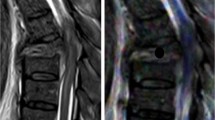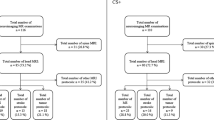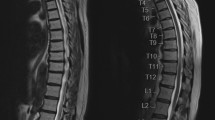Abstract
Objective
To investigate the feasibility of compressed sensing MRI (CS-MRI) in the application of 2D spinal imaging and compare its performance with conventional MR imaging (non-CS-MRI).
Methods
The CS imaging protocol was optimized on 5 volunteers. Non-CS-MRI and CS-MRI of 2D sagittal T1 weighted imaging (WI), Sag T2WI, and axial T2WI were performed for 71 patients (22 cervical, 8 thoracic, 41 lumbar MRI). Paired t tests were conducted to compare the total scan time. Three radiologists assessed image quality and lesion diagnosis independently. A Kendall W test was performed to assess interobserver agreement of the image quality scores and lesion diagnosis between readers. A nonparametric test (Wilcoxon test) was performed to compare the image quality. For lesion diagnosis, the interobserver and interstudy agreements were evaluated by kappa analysis. Paired t tests were conducted for SNR and CNR comparison.
Results
The mean scan time for spine CS-MRI (4 min 28.7 s ± 34.6 s) was significantly shorter than that with non-CS-MRI (7 min 21.3 s ± 38.7 s, t = − 47.464, P < 0.0001). CS-MRI achieved higher SNR and CNR than Non-CS-MRI in image quality assessment. Interobserver agreements of lesion diagnosis were excellent between non-CS-MRI and CS-MRI (kappa value from 0.913 to 1.000, P < 0.001). Interstudy agreements of lesion assessments were also excellent (kappa value = 1.000, with P < 0.001).
Conclusion
CS-MRI spine imaging can significantly reduce the scan time, while maintaining comparable imaging quality to non-CS-MRI.






Similar content being viewed by others
References
Taber KH, Herrick RC, Weathers SW, Kumar AJ, Hayman LA. Pitfalls and artifacts encountered in clinical MR imaging of the spine. Radiographics. 1998;18(6):1499–521. https://doi.org/10.1148/radiographics.18.6.9821197.
Hermann KGA, Althoff CE, Schneider U, Zühlsdorf S, Lembcke A, Hamm B, et al. Spinal changes in patients with spondyloarthritis: comparison of MR imaging and radiographic appearances. Radiographics. 2005;25(3):570–569. https://doi.org/10.1023/A:1015523611397.
Groves CJ, Cassarpullicino VN, Tins BJ, Tyrrell PN, Mccall IW. Chance-type flexion-distraction injuries in the thoracolumbar spine: MR imaging characteristics. Radiology. 2005;236(2):601–8. https://doi.org/10.1148/radiol.2362040281.
Arnbak B, Jensen TS, Egund N, Zejden A, Hørslev-Petersen K, Manniche C, et al. Prevalence of degenerative and spondyloarthritis-related magnetic resonance imaging findings in the spine and sacroiliac joints in patients with persistent low back pain. Eur Radiol. 2016;26(4):1191–203. https://doi.org/10.1007/s00330-015-3903-0.
Lyu FJ, Cui H, Pan H, Mc Cheung K, Cao X, Iatridis JC, et al. Painful intervertebral disc degeneration and inflammation: from laboratory evidence to clinical interventions. Bone Res. 2021;9(1):7. https://doi.org/10.1038/s41413-020-00125-x.
Pillastrini P, Gardenghi I, Bonetti F, Capra F, Guccione A, Mugnai R, et al. An updated overview of clinical guidelines for chronic low back pain management in primary care. Joint Bone Spine. 2012;79(2):176–85. https://doi.org/10.1016/j.jbspin.2011.03.019.
Robertson WD, Jarvik JG, Tsuruda JS, Koepsell TD, Maravilla KR. The comparison of a rapid screening MR protocol with a conventional MR protocol for lumbar spondylosis. AJR. 1996;166:909–16. https://doi.org/10.2214/AJR.15.15764.
Iida T, Abumi K, Kotani Y, Kaneda K. Effects of aging and spinal degeneration on mechanical properties of lumbar supraspinous and interspinous ligaments. Spine J. 2002;2(2):95–100. https://doi.org/10.1016/s1529-9430(02)00142-0.
Urban JP, Roberts S. Degeneration of the intervertebral disc. Arthritis Res Ther. 2003;5(3):120–30. https://doi.org/10.1186/ar629.
European Society of Skeletal Radiology. Guidelines for MR imaging of sports injuries. https://essr.org/content-essr/uploads/2016/10/ ESSR-MRI-Protocols-Spine.pdf. Accessed May 31, 2018.
Taron J, Weiss J, Notohamiprodjo M, Kuestner T, Bamberg F, Weiland E, et al. Acceleration of magnetic resonance cholangiopancreatography using compressed sensing at 1.5 and 3 T. Investigative Radiology 2018;53(11): 681–688. https://doi.org/10.1097/RLI.0000000000000489.
Lohöfer FK, Kaissis GA, Rasper M, Katemann C, Hock A, Peeters JM, et al. Magnetic resonance cholangiopancreatography at 3 Tesla: image quality comparison between 3D compressed sensing and 2D single-shot acquisitions. Eur J Radiol. 2019;115:53–8. https://doi.org/10.1016/j.ejrad.2019.04.002.
Garwood ER, Recht MP, White LM. Advanced imaging techniques in the knee: Benefits and limitations of new rapid acquisition strategies for routine knee MRI. AJR Am J Roentgenol. 2017;209:552–60. https://doi.org/10.2214/AJR.17.18228.
Lin Z, Zhang X, Guo L, Wang K, Jiang Y, Hu X, et al. Clinical feasibility study of 3D intracranial magnetic resonance angiography using compressed sensing. J Magn Reson Imaging. 2019;50:1843–51. https://doi.org/10.1002/jmri.26752.
Vranic JE, Cross NM, Wang Y, Hippe DS, de Weerdt E, Mossa-Basha M. Compressed sensing-sensitivity encoding (CS-SENSE) accelerated brain imaging: reduced scan time without reduced image quality. AJNR Am J Neuroradiol. 2019;40(1):92–8. https://doi.org/10.3174/ajnr.A5905.
Bratke G, Rau R, Weiss K, Kabbasch C, Sircar K, Morelli JN, et al. Accelerated MRI of the lumbar spine using compressed sensing: quality and efficiency. J Magn Reson Imaging. 2019;49(7):e164–75. https://doi.org/10.1002/jmri.26526.
Morita K, Nakaura T, Maruyama N, Iyama Y, Oda S, Utsunomiya D, et al. Hybrid of compressed sensing and parallel imaging applied to three-dimensional isotropic T2-weighted Turbo spin-echo MR imaging of the lumbar spine. Magn Reson Med Sci. 2020;19(1):48–55. https://doi.org/10.2463/mrms.mp.2018-0132.
Yang AC, Kretzler M, Sudarski S, Gulani V, Seiberlich N. Sparse reconstruction techniques in magnetic resonance imaging: methods, applications, and challenges to clinical adoption. Invest Radiol. 2016;51(6):349–64. https://doi.org/10.1097/RLI.0000000000000274.
Hollingsworth KG. Reducing acquisition time in clinical MRI by data undersampling and compressed sensing reconstruction. Phys Med Biol. 2015;60(21):R297-322. https://doi.org/10.1088/0031-9155/60/21/R297.
Fan X, Lian Q, Shi B. Compressed sensing MRI based on image decomposition model and group sparsity. Magn Reson Imaging. 2019;60:101–9. https://doi.org/10.1016/j.mri.2019.03.011.
Feng L, Benkert T, Block KT, Sodickson DK, Otazo R, Chandarana H. Compressed sensing for body MRI. J Magn Reson Imaging. 2017;45(4):966–87. https://doi.org/10.1002/jmri.25547.
Jaspan ON, Fleysher R, Lipton ML. Compressed sensing MRI: a review of the clinical literature. Br J Radiol. 2015;88(1056):20150487. https://doi.org/10.1259/bjr.20150487.
Ikeda H, Ohno Y, Murayama K, Yamamoto K, Iwase A, Fukuba T, et al. Compressed sensing and parallel imaging accelerated T2 FSE sequence for head and neck MR imaging: comparison of its utility in routine clinical practice. Eur J Radiol. 2021;135: 109501. https://doi.org/10.1016/j.ejrad.2020.109501.
Mo ̈nch S, Sollmann N, Hock A, Zimmer C, Kirschke JS, Hedderich DM. Magnetic resonance imaging of the brain using compressed sensing - quality assessment in daily clinical routine. Clin Neuroradiol. 2020;30(2):279–86. https://doi.org/10.1007/s00062-019-00789-x.
Uecker M, Lai P, Murphy MJ, Virtue P, Elad M, Pauly JM, et al. ESPIRiT—an eigenvalue approach to autocalibrating parallel MRI: where SENSE meets GRAPPA. Magn Reson Med. 2014;71:990–1001. https://doi.org/10.1002/mrm.24751.
Lustig M, Donoho D, Pauly JM. Sparse MRI: the application of compressed sensing for rapid MR imaging. Magn Reson Med. 2007;58:1182–95. https://doi.org/10.1002/mrm.21391.
Obyn C, Cleemput I. The capital cost and productivity of MRI in a Belgian setting. JBR-BTR. 2010;93(2):92–6. https://doi.org/10.1016/j.jcmg.2010.01.003.
Author information
Authors and Affiliations
Corresponding author
Ethics declarations
Conflict of interest
The authors declare no competing interests.
Additional information
Publisher's note
Springer Nature remains neutral with regard to jurisdictional claims in published maps and institutional affiliations.
Jianxing Qiu and Jing Liu contributed equally to this work
Supplementary Information
Below is the link to the electronic supplementary material.
Rights and permissions
About this article
Cite this article
Qiu, J., Liu, J., Bi, Z. et al. An Investigation of 2D Spine Magnetic Resonance Imaging (MRI) with Compressed Sensing (CS). Skeletal Radiol 51, 1273–1283 (2022). https://doi.org/10.1007/s00256-021-03954-x
Received:
Revised:
Accepted:
Published:
Issue Date:
DOI: https://doi.org/10.1007/s00256-021-03954-x




